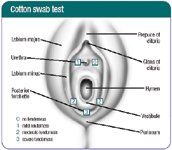Is it vulvar vestibulitis?
Diagnosing and treating women with vulvar vestibulitis can sometimes seem more art than science. Here an expert reviews the available evidence and describes his approach.

A few words about terminology

What is vulvar vestibulitis syndrome?
VVS is a condition whose primary hall-mark is dyspareunia with intromission. Although exact data on the prevalence of VVS in the general population remain scarce, certain studies suggest that it's a common condition. In a mail and telephone survey of 4,915 Boston-area women, Harlow and colleagues found that 16% of surveyed women reported a history of chronic knifelike or excessive pain on contact with the genital area lasting for at least 3 months or longer, and 7% were experiencing it at the time of the survey.3 Similarly, we've found VVS in up to 15% of patients referred to a tertiary care center for evaluation of chronic vaginal and vulvar symptoms.4 These studies suggest that VVS is a fairly common cause of vulvar pain.

